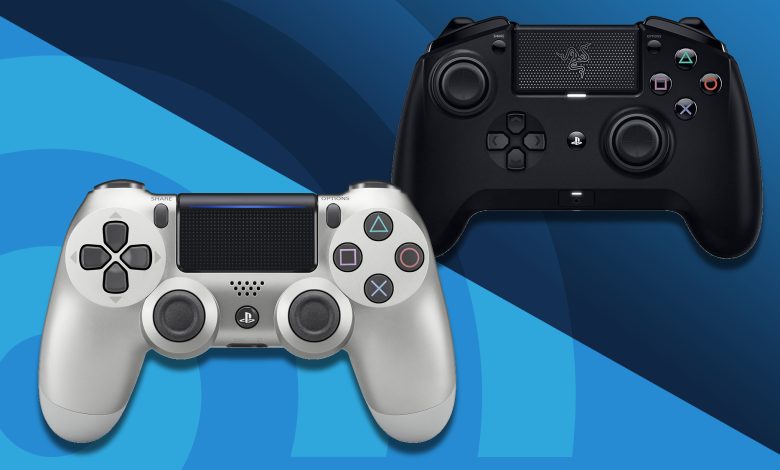The Evolution and Impact of the DualShock Controller in Gaming
DualShock Controller in Gaming

Introduction:
The DualShock controller stands as an icon in the world of gaming, representing more than just a means of input but embodying the very essence of immersive gameplay. From its humble beginnings to its revolutionary iterations, the DualShock has played a pivotal role in shaping how we interact with virtual worlds. This article delves into the rich history, evolution, and profound impact of the DualShock controller on the gaming landscape.
Origins and Development:
The story of the DualShock controller begins with Sony’s foray into the gaming industry with the original PlayStation console in 1994. While the PlayStation introduced groundbreaking graphics and gameplay, its initial controller, the PlayStation Controller (later dubbed Dual Analog Controller), lacked the refined ergonomics and features that would define future generations. It wasn’t until 1997 when Sony released the DualShock controller alongside the PlayStation console that gaming entered a new era.The DualShock controller, aptly named for its dual analog sticks and vibrating feedback, marked a significant leap forward in gaming technology. Its ergonomic design offered players greater precision and control, while the inclusion of force feedback enhanced immersion by providing tactile responses to in-game actions. This combination of features set a new standard for controllers and established Sony as a leader in the industry.
Origins and Development: Tracing the Evolution of Gaming
Introduction:
The world of gaming, a multi-billion dollar industry that spans across continents, has its roots deeply embedded in human history. From ancient civilizations engaging in strategic board games to the digital landscapes of modern video games, the evolution of gaming is a fascinating journey that reflects the advancements in technology, culture, and human creativity. This article explores the origins and development of gaming, tracing its trajectory from ancient times to the digital age.
Ancient Beginnings:
Gaming, in various forms, has been a part of human civilization for thousands of years. Archaeological evidence suggests that ancient civilizations such as the Mesopotamians, Egyptians, and Greeks engaged in various forms of board games, often using rudimentary game pieces and dice. These early games served not only as forms of entertainment but also as tools for socialization, education, and even religious rituals. One of the oldest known board games is Senet, played in ancient Egypt over 5,000 years ago. It featured a grid of squares and symbolic gameplay, reflecting the journey of the soul through the afterlife. Similarly, the ancient Indian game of Chaturanga, believed to be the precursor to chess, dates back to around 600 AD and involved strategic gameplay and military tactics.
The Emergence of Modern Gaming:
The modern era of gaming began to take shape in the 20th century with the advent of electronic and digital technologies. In the mid-20th century, innovations such as cathode-ray tube (CRT) displays and transistors laid the groundwork for the development of early electronic games. One of the earliest electronic games was “Tennis for Two,” created by physicist William Higinbotham in 1958, which simulated a game of tennis using an oscilloscope display. The 1970s witnessed the birth of the arcade industry, marked by the release of iconic games such as “Pong” and “Space Invaders.” These games, featuring simple yet addictive gameplay, captivated audiences worldwide and laid the foundation for the burgeoning video game industry. The introduction of home consoles like the Atari 2600 in the late 1970s further popularized gaming, bringing the arcade experience into the living room.
The Golden Age of Gaming:
The 1980s and early 1990s are often regarded as the golden age of gaming, characterized by rapid technological advancements and the proliferation of iconic franchises. This era saw the rise of influential gaming companies such as Nintendo, Sega, and Capcom, who introduced groundbreaking titles like “Super Mario Bros.,” “The Legend of Zelda,” and “Sonic the Hedgehog.” The introduction of 8-bit and 16-bit consoles revolutionized gaming, allowing developers to create more immersive worlds with vibrant graphics and engaging gameplay. These consoles also introduced popular accessories such as light guns, joysticks, and gamepads, further enhancing the gaming experience.
The Evolution of Digital Gaming:
The late 20th and early 21st centuries witnessed a seismic shift in gaming with the rise of digital technology and the internet. The advent of personal computers and gaming consoles with CD-ROM drives enabled developers to create more complex and visually stunning games. The emergence of online gaming platforms and multiplayer networks allowed players to connect with others around the world, ushering in a new era of social gaming. The 2000s saw the rise of 3D graphics and immersive gameplay experiences, with titles like “Half-Life,” “Halo: Combat Evolved,” and “World of Warcraft” pushing the boundaries of storytelling and interactive entertainment. The introduction of motion-sensing controllers, virtual reality (VR) headsets, and augmented reality (AR) devices further expanded the possibilities for gaming, blurring the lines between the virtual and real worlds.
The Present and Future of Gaming:
In the present day, gaming has become a global phenomenon, with millions of players engaging in diverse genres and platforms. From mobile games and indie titles to blockbuster AAA releases, the gaming industry continues to evolve and innovate at a rapid pace. Advancements in artificial intelligence, cloud gaming, and streaming services promise to shape the future of gaming, offering new opportunities for creativity, accessibility, and immersive experiences.
Conclusion:
The origins and development of gaming are a testament to human ingenuity, creativity, and the relentless pursuit of innovation. From ancient board games to cutting-edge virtual reality experiences, gaming has evolved into a diverse and dynamic form of entertainment that transcends cultural boundaries and generations. As we look towards the future, one thing is certain: the journey of gaming is far from over, and the possibilities are limitless.
Evolution and Innovation:
Over the years, Sony continued to refine and innovate upon the DualShock design with each new iteration of the PlayStation console. The DualShock 2, released with the PlayStation 2 in 2000, introduced pressure-sensitive buttons and improved analog sensitivity, further enhancing gameplay experiences. It became synonymous with iconic titles such as “Grand Theft Auto: Vice City” and “Metal Gear Solid 2: Sons of Liberty,” cementing its place in gaming history.
The PlayStation 3 ushered in the era of wireless gaming with the introduction of the DualShock 3 controller, featuring Bluetooth connectivity and motion-sensing capabilities. This iteration expanded the possibilities for immersive gameplay, particularly with titles like “Uncharted” and “Heavy Rain,” which leveraged motion controls for enhanced interaction. In 2013, Sony unveiled the PlayStation 4 alongside the DualShock 4 controller, marking another significant evolution in controller design. The DualShock 4 featured a touchpad, integrated light bar, and improved triggers, offering developers new avenues for innovation and creativity. Titles like “Bloodborne” and “The Last of Us Part II” demonstrated the controller’s versatility, utilizing its features to enrich gameplay and storytelling.
Evolution and Innovation in Gaming: A Journey Through Technological Advancements
Introduction:
Gaming has undergone a remarkable evolution over the decades, propelled by groundbreaking technological advancements and the relentless pursuit of innovation. From humble beginnings as simple electronic diversions to immersive virtual worlds that blur the lines between reality and fiction, the evolution of gaming is a testament to human creativity, ingenuity, and the power of technology. This article delves into the key stages of evolution and innovation in gaming, highlighting the transformative impact of technological advancements on the gaming industry.
Early Innovations:
The origins of gaming can be traced back to the mid-20th century with the development of electronic and digital technologies. Early innovations such as cathode-ray tube (CRT) displays and transistors paved the way for the creation of simple electronic games like “Tennis for Two” and “Spacewar!” These rudimentary games laid the groundwork for the burgeoning video game industry, captivating audiences with their novelty and simplicity.
The Golden Age of Arcade:
The 1970s and 1980s are often referred to as the golden age of arcade gaming, marked by the rise of iconic titles such as “Pong,” “Pac-Man,” and “Donkey Kong.” These games, featuring colorful graphics and addictive gameplay, captivated audiences worldwide and popularized the arcade culture. The advent of microprocessors and hardware advancements enabled developers to create more complex and visually stunning arcade cabinets, further fueling the arcade boom.
Home Console Revolution:
The late 1970s and early 1980s saw the emergence of home consoles, bringing the arcade experience into the living room. The release of consoles like the Atari 2600, Intellivision, and ColecoVision revolutionized gaming, offering players a wide range of titles to enjoy in the comfort of their homes. These consoles introduced iconic franchises such as “Super Mario Bros.,” “The Legend of Zelda,” and “Final Fantasy,” laying the foundation for the modern gaming landscape.
The Rise of Personal Computers:
The 1980s also witnessed the rise of personal computers (PCs) as viable gaming platforms. The introduction of home computers like the Commodore 64, Amiga, and IBM PC opened up new possibilities for gaming, allowing developers to create more complex and sophisticated games. The PC gaming market thrived with the release of groundbreaking titles such as “Doom,” “Ultima,” and “Warcraft,” establishing PCs as a dominant force in the gaming industry.
The 3D Revolution:
The 1990s ushered in the era of 3D graphics, transforming gaming with immersive environments and realistic visuals. The introduction of 3D accelerators and graphics processing units (GPUs) enabled developers to create more lifelike characters, dynamic worlds, and cinematic experiences. Games like “Quake,” “Tomb Raider,” and “Final Fantasy VII” showcased the potential of 3D technology, pushing the boundaries of storytelling and interactive entertainment.
Convergence of Gaming and Multimedia:
The turn of the millennium witnessed the convergence of gaming with multimedia and the internet. The rise of CD-ROMs, DVDs, and online gaming platforms opened up new avenues for storytelling, cinematic cutscenes, and multiplayer experiences. Games like “Half-Life,” “Metal Gear Solid,” and “Diablo II” blurred the lines between gaming and cinema, offering immersive narratives and cinematic presentations.
The Emergence of Mobile and Casual Gaming:
The 2000s saw the rise of mobile and casual gaming, driven by advancements in mobile technology and the proliferation of smartphones and tablets. The introduction of app stores and digital distribution platforms revolutionized the gaming industry, democratizing access to games and empowering indie developers. Titles like “Angry Birds,” “Candy Crush Saga,” and “Flappy Bird” captivated audiences with their simplicity, accessibility, and addictive gameplay.
The Era of Virtual Reality and Augmented Reality:
In recent years, gaming has entered a new frontier with the emergence of virtual reality (VR) and augmented reality (AR) technologies. VR headsets like the Oculus Rift, HTC Vive, and PlayStation VR offer immersive experiences that transport players to virtual worlds, while AR devices like the Microsoft HoloLens and Pokémon GO blend digital content with the real world. These technologies promise to revolutionize gaming, offering new levels of immersion, interactivity, and socialization.
Conclusion:
The evolution and innovation in gaming have been driven by a relentless pursuit of technological advancements and creative expression. From the early days of simple electronic games to the immersive virtual worlds of today, gaming has continually pushed the boundaries of what is possible, captivating audiences with its innovation, creativity, and ingenuity. As we look towards the future, one thing is certain: the journey of gaming is far from over, and the possibilities are endless.
Impact on Gaming Culture:
The impact of the DualShock controller extends far beyond its technical specifications. It has become an integral part of gaming culture, synonymous with immersive experiences and memorable moments. From epic battles to heart-pounding chases, the DualShock controller has been the conduit through which players have forged unforgettable connections with virtual worlds. Moreover, DualShock’s influence extends to the broader gaming industry, inspiring competitors to innovate and iterate upon controller designs. Its success has spurred advancements in haptic feedback, motion controls, and adaptive triggers, shaping the direction of gaming technology for years to come.
Conclusion:
In conclusion, the DualShock controller stands as a testament to the power of innovation and design in gaming. From its inception to the present day, it has continually pushed the boundaries of what is possible, enriching gameplay experiences and leaving an indelible mark on gaming culture. As we look towards the future, one thing remains certain: the legacy of the DualShock controller will endure, shaping the way we play and interact with games for generations to come.
Introduction to DualShock Controller
The DualShock controller has been an integral part of the gaming experience for decades, evolving alongside gaming technology to provide users with an immersive and intuitive way to interact with their favorite games. Initially introduced by Sony for the PlayStation console, the DualShock controller has become synonymous with gaming due to its innovative features and ergonomic design.
Overview of DualShock Controller’s History and Development
The DualShock controller made its debut in 1997 with the release of the original PlayStation console. Since then, it has undergone several iterations, each incorporating new features and improvements to enhance the gaming experience. The evolution of the DualShock controller has been driven by advancements in technology and user feedback, resulting in a device that continues to set the standard for gaming controllers.
Explanation of its Features and Functionality
The DualShock controller is equipped with a range of features designed to provide users with precise control and feedback during gameplay. These features include analog sticks, directional buttons, action buttons, triggers, and a touchpad, all of which contribute to the controller’s versatility and responsiveness. Additionally, the controller incorporates motion controls and audio options, further expanding its capabilities.
Importance of Using a DualShock Controller for an Enhanced Gaming Experience
The DualShock controller plays a crucial role in enhancing the gaming experience by offering intuitive controls and immersive feedback. Its ergonomic design and responsive buttons allow players to engage with games in a natural and seamless manner, resulting in heightened enjoyment and improved performance. Whether playing action-packed titles or immersive adventures, the DualShock controller’s contribution to the gaming experience cannot be overstated.
Setting Up a DualShock Controller
Setting up a DualShock controller is a straightforward process that varies depending on the gaming platform being used. Whether connecting to a PC or a PlayStation console, the following step-by-step guide will ensure a smooth setup experience.
Conclusion:
The DualShock controller stands as a testament to the evolution of gaming technology, offering users a versatile and immersive way to engage with their favorite games. By mastering its functions, customizing settings, and exploring advanced features, users can unlock the full potential of the DualShock controller and elevate their gaming experiences to new heights.
Introduction to DualShock controllers
As a passionate gamer, I’m always on the lookout for ways to enhance my gaming experience and take it to the next level. One of the key factors that can make or break your gaming session is the controller you use. In this ultimate guide, I will delve into the world of DualShock controllers and show you how they can revolutionize your gaming experience like never before.
Evolution of DualShock controllers
The journey of DualShock controllers began back in 1997 with the release of the original PlayStation console. Since then, the controllers have evolved significantly to meet the changing needs and demands of gamers. The introduction of the DualShock 2 brought analog sticks, vibration feedback, and improved ergonomics, while the DualShock 3 introduced wireless connectivity and motion-sensing capabilities. Finally, the DualShock 4, which is the current iteration, added a touchpad, improved triggers, and a built-in speaker.
Features and functionality of DualShock controllers
DualShock controllers are packed with a wide range of features and functionalities that make them a favorite among gamers worldwide. From the iconic button layout to the precise analog sticks, every aspect of the controller is designed with the utmost care and attention to detail. The inclusion of vibration feedback adds a new level of immersion to your gaming experience, allowing you to feel every hit, crash, and explosion. Additionally, the touchpad on the DualShock 4 opens up new possibilities for innovative gameplay mechanics.
How to connect and set up DualShock controllers
Setting up your DualShock controller is a breeze, regardless of the gaming platform you’re using. For PlayStation consoles, simply connect the controller via USB or use Bluetooth to pair it wirelessly. On PC, you can use a USB cable or a Bluetooth adapter to connect the controller. Once connected, your system will automatically recognize the controller, and you’ll be ready to dive into your favorite games.
Customizing and optimizing DualShock controllers for your gaming experience
One of the great advantages of DualShock controllers is the ability to customize and optimize them according to your preferences. With the help of the PlayStation companion app or third-party software on PC, you can remap buttons, adjust sensitivity settings, and even create custom profiles for different genres of games. This level of customization ensures that you have complete control over your gaming experience, allowing you to fine-tune the controller to suit your playstyle.
Tips and tricks for using DualShock controllers effectively
To truly master the art of gaming with a DualShock controller, it’s important to keep a few tips and tricks in mind. Firstly, make sure to maintain a comfortable grip on the controller to avoid fatigue during long gaming sessions. Secondly, take advantage of the controller’s built-in speaker to immerse yourself in the game’s audio. Finally, explore the different control options available in games to find the setup that works best for you.
DualShock controller compatibility with different gaming platforms
DualShock controllers are not limited to PlayStation consoles. In fact, they can be used with a wide range of gaming platforms, including PC, Mac, and even mobile devices. With the right adapters or Bluetooth connectivity, you can enjoy the familiar feel and functionality of DualShock controllers across various gaming platforms. This versatility makes them a worthwhile investment for any gamer.
Enhancing your gaming experience with DualShock controllers – immersive features and game-specific functionalities
DualShock controllers are designed to enhance your gaming experience in more ways than one. From the immersive vibration feedback to the precise motion-sensing capabilities, every feature is meticulously crafted to immerse you in the game world. Furthermore, many games utilize the unique functionalities of the DualShock controllers, such as the touchpad or gyroscopic sensors, to provide unique gameplay experiences. Whether you’re playing a first-person shooter, a racing game, or a role-playing adventure, DualShock controllers add an extra layer of immersion and enjoyment.
DualShock controller accessories and add-ons for further customization
If you’re looking to take your DualShock controller customization to the next level, there are a plethora of accessories and add-ons available. From controller grips and thumbstick covers to trigger extenders and charging docks, these accessories can enhance your comfort, control, and overall gaming experience. Additionally, you can find a variety of skins and decals to personalize the look of your controller, adding a touch of style to your gaming setup.
Troubleshooting common issues with DualShock controllers
While DualShock controllers are renowned for their reliability, occasional issues may arise. If you encounter problems such as input lag, connectivity issues, or unresponsive buttons, there are a few troubleshooting steps you can take. Firstly, make sure your controller is fully charged or connected properly. If the issue persists, try resetting the controller or updating its firmware. In most cases, these simple steps should resolve common issues and get you back to gaming in no time.
Conclusion and final thoughts on maximizing your gaming experience with DualShock controllers
In conclusion, DualShock controllers have come a long way since their inception and have become an integral part of the gaming landscape. With their intuitive design, immersive features, and game-specific functionalities, they truly elevate your gaming experience to new heights. By customizing and optimizing your DualShock controller, exploring its compatibility with different platforms, and utilizing accessories for further customization, you can unlock the full potential of these remarkable controllers. So, grab your DualShock controller, dive into your favorite game, and let it transport you to a world of unparalleled gaming enjoyment.











